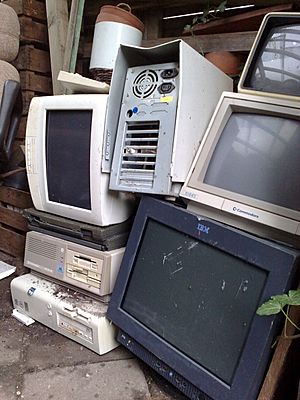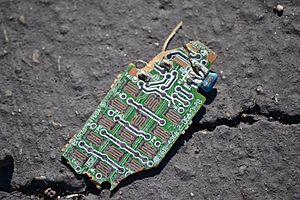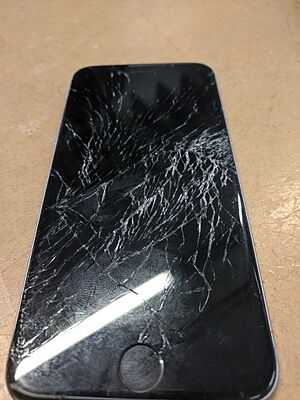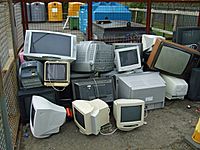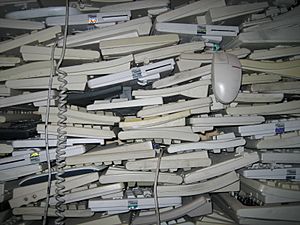Electronic waste facts for kids
Electronic waste (or e-waste) is a fancy name for old or broken electrical and electronic gadgets. You might also hear it called WEEE (Waste Electrical and Electronic Equipment) or EOL (End-of-Life) electronics. This includes any used electronics that are thrown away, or even those meant to be fixed, reused, sold again, or recycled for their parts.
Contents
What is E-waste?
E-waste is created when an electronic product is no longer useful and gets thrown away. Our world changes very fast with new technology. People also like to buy new things often. This leads to a huge amount of e-waste being made.
In the US, the United States Environmental Protection Agency (EPA) sorts e-waste into ten groups:
- Large home appliances (like fridges)
- Small home appliances (like toasters)
- Computers and screens
- TVs and other entertainment gadgets
- Lamps and lights
- Toys
- Tools
- Medical devices
- Monitoring tools
- Vending machines
These groups include electronics that can be reused, sold, or recycled for materials like copper or plastic. The word "waste" is mainly for things that are just dumped. Some people use "e-waste" to mean all old electronics. Old TV screens (called CRTs) are some of the hardest to recycle.
Another group, the Partnership on Measuring ICT for Development, uses six categories:
- Air conditioners and freezers
- Screens and monitors (TVs, laptops)
- Lamps (like LED lights)
- Large equipment (washing machines, stoves)
- Small equipment (microwaves, electric shavers)
- Small IT and phone equipment (mobile phones, printers)
How Much E-waste Is There?
E-waste is growing faster than any other type of trash in the world. In 2016, about 44.7 million tons were made. That's like 4,500 Eiffel Towers! By 2018, it was about 50 million tons. The UN calls this a 'tsunami of e-waste'. This waste is worth at least $62.5 billion every year.
Technology changes quickly, and prices keep falling. Also, some products are made to break or become old-fashioned quickly (this is called planned obsolescence). All these things make e-waste pile up around the world.
Our lives today depend on technology. We always want the newest and best gadgets. This adds to the huge amount of e-waste. Since the first iPhone, cell phones have become a top source of e-waste.
Even Bitcoin mining adds to e-waste. It's thought that the bitcoin network throws away as much "small IT and telecommunication equipment" as a country like the Netherlands each year. This is about 30.7 thousand tons.
In 2021, about 57.4 million tons of e-waste were made globally. In Europe, where this problem is studied well, 11 out of 72 electronic items in an average home are broken or not used. Each year, people in Europe also keep 4 to 5 kg of unused electronics before throwing them away. In 2021, less than 20% of e-waste was collected and recycled.
In 2022, the amount of e-waste grew by 3.4% globally, reaching 59.4 million tons. This means over 347 million tons of e-waste have not been recycled by 2022.
Guiyu, China
Guiyu in China is a huge place where e-waste is processed. It's often called the "e-waste capital of the world." Guiyu used to be a farming town. But in the mid-1990s, it changed into an e-waste recycling center. Over 75% of local families and 100,000 extra workers are involved.
Thousands of small workshops hire people to cut wires, pull chips from circuit boards, grind plastic computer cases, and dip circuit boards in acid. This helps get out valuable metals. Others strip wires to get small amounts of copper.
Burning, taking apart, and throwing away e-waste without rules causes many problems. It pollutes groundwater, air, and water. This also leads to health problems for workers and people nearby.
Six villages in Guiyu focus on taking apart circuit boards. Seven work on plastics and metals. Two villages take apart wires and cables. Greenpeace, an environmental group, tested dust, soil, river mud, and groundwater in Guiyu. They found very high levels of toxic heavy metals and other harmful chemicals. One campaigner found "over 10 poisonous metals, such as lead, mercury, and cadmium."
Guiyu is just one example. Similar places can be found in Nigeria, Ghana, and India.
How E-waste Harms the Environment
When e-waste is processed in developing countries without proper safety, it can harm people's health and pollute the environment.
Harmful liquids and gases from e-waste go into water, soil, and air. This means they can get into animals (both farm animals and wild ones), crops we eat, and drinking water.
A study in Guiyu, China, found these environmental problems:
- Very high levels of airborne dioxins (a harmful chemical).
- Levels of cancer-causing chemicals in duck ponds and rice fields were too high.
- Heavy metals in road dust were extremely high. Lead was over 300 times higher than in a clean village. Copper was over 100 times higher.
Harmful Stuff in E-waste
Electronic waste has both dangerous and valuable materials. Up to 60 different elements can be found in complex electronics. The amount of metals in e-waste is often higher than in natural ores. These include copper, aluminum, iron, gold, silver, and palladium.
Parts like CPUs can have harmful materials. These include lead, cadmium, beryllium, or brominated flame retardants. Recycling and getting rid of e-waste can be risky for workers and their communities.
Hazardous Materials

| E-waste Component | Where it's found | Harmful Health Effects |
|---|---|---|
| Americium | In smoke alarms. | Can cause cancer. |
| Lead | In solder, old TV screens, and batteries. An old 15-inch TV screen can have 1.5 pounds of lead. | Harms brain function, causes behavior problems, and lowers IQ. It's most harmful to children's developing brains. |
| Mercury | In fluorescent tubes and flat screen monitors. | Can cause memory loss, skin problems, and muscle weakness. If pregnant mothers are exposed, it can harm the baby's development. |
| Cadmium | In light sensors and nickel–cadmium batteries. | Breathing it in can damage lungs and kidneys. It can also affect children's thinking and learning. |
| Hexavalent chromium | Used to coat metals to stop rust. | Can cause lung cancer if breathed in. |
| Sulfur | In lead–acid batteries. | Can harm the liver, kidneys, and heart. It can also irritate eyes and throat. |
| Brominated Flame Retardants (BFRs) | In plastics to stop fires. | Can harm the nervous system, thyroid, and liver. |
| Perfluorooctanoic acid (PFOA) | In some electronics and non-stick pans. | Can harm the liver and development. In pregnant mothers, it can increase risk of miscarriage or early birth. |
| Beryllium oxide | In some computer parts and X-ray machines. | Can cause lung cancer and other lung diseases. |
| Polyvinyl chloride (PVC) | Used as insulation for electrical wires. | Making it releases toxic chemicals. It can pollute air, water, and soil. Can affect reproduction and development. |
Materials That Are Usually Not Hazardous
| E-waste component | Where it's found |
|---|---|
| Aluminum | In many electronics that use power, like heatsinks. |
| Copper | In wires, printed circuit boards, and parts. |
| Germanium | In old transistors from the 1950s-60s. |
| Gold | Used for coating connectors, especially in computers. |
| Lithium | In Lithium-ion batteries. |
| Nickel | In Nickel–cadmium batteries. |
| Silicon | In glass, transistors, and printed circuit boards. |
| Tin | In solder and coatings on parts. |
| Zinc | Used for plating steel parts. |
How E-waste Affects People's Health
People Living Near Recycling Sites
People who live near e-waste recycling sites can get sick. Even if they don't work with e-waste, they can breathe in bad air, drink polluted water, or eat contaminated food. This is because harmful chemicals from e-waste get into the air, water, soil, and dust.
Studies show that people living near these sites have more heavy metals in their bodies. This can lead to mental health issues, problems with thinking, and other physical health problems. Damage to DNA has also been found more often in people living near e-waste sites. DNA damage can increase the risk of mutations and even cancer.
Children and E-waste
Children are especially sensitive to e-waste pollution. This is because their bodies and brains are still growing.
Exposure to toxins in e-waste can cause serious health problems for kids. It can lead to lower IQ, problems with thinking, and exposure to chemicals that cause cancer. In some areas, children living near e-waste sites have weaker lung function. Studies also found that e-waste exposure in children can affect blood clotting, cause hearing loss, and weaken their body's response to vaccines.
E-waste Recycling Workers
E-waste is made of many different things. When it's not handled safely, it can harm the health of workers.
The Occupational Safety and Health Administration (OSHA) lists several dangers for recycling workers:
| Hazards | Details |
|---|---|
| Slips, trips, and falls | Can happen when collecting and moving e-waste. |
| Crushing hazards | Workers can get stuck or crushed by machines or e-waste. Traffic accidents can happen when moving e-waste. Machines with moving parts can cause injuries like crushed fingers. |
| Hazardous energy released | Machines starting up unexpectedly can cause serious injury or death. This can happen during setup, repair, or maintenance. |
| Cuts and scrapes | Workers can get cuts or eye injuries when taking apart e-waste with sharp edges. |
| Noise | Working too long near loud noises from tools can cause hearing loss. |
| Toxic chemicals (dusts) | Burning e-waste to get metals releases toxic chemicals (like lead) into the air. Workers can breathe or swallow these, leading to illness. |
Keeping Your Information Safe
Old computers and phones might still have your personal information on them. A good recycling plan makes sure that all sensitive data is properly erased. This can mean wiping the hard drive clean or even physically destroying the storage parts.
Recycling E-waste
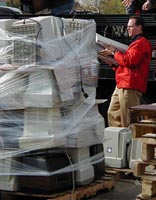
Recycling is a very important part of managing e-waste. If done correctly, it can greatly reduce how many toxic materials leak into the environment. However, local governments and schools need to encourage it. Less than 20% of e-waste is recycled properly. About 80% ends up in landfills or is recycled by hand in developing countries. This exposes workers to dangerous chemicals like mercury, lead, and cadmium.
Helping People Recycle
Some stores in the U.S. offer ways for customers to recycle old electronics. The Consumer Electronics Association (CEA) helps people find places to recycle their old electronics through its recycling locator. CEA research shows that 58% of people know where to take their old electronics. The electronics industry wants this number to grow even more. Manufacturers and stores support over 5,000 recycling spots across the country. They promised to recycle one billion pounds each year by 2016, which is a big jump from 300 million pounds in 2010.
See also
 In Spanish: Chatarra electrónica para niños
In Spanish: Chatarra electrónica para niños


